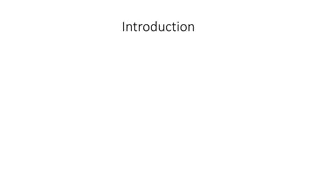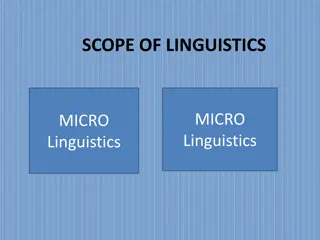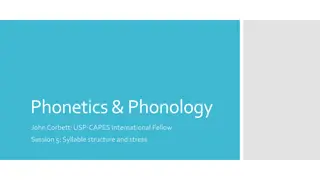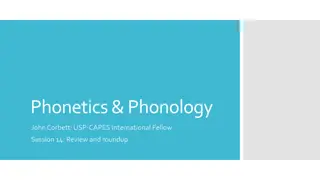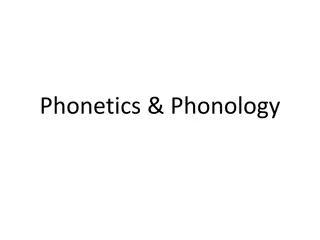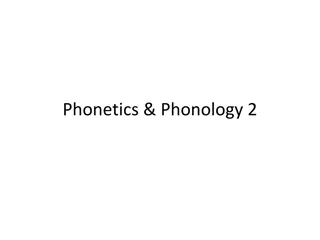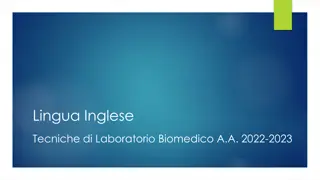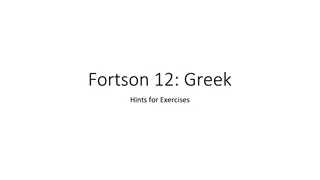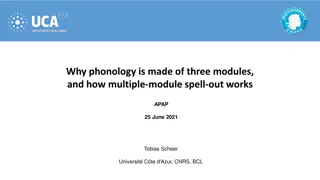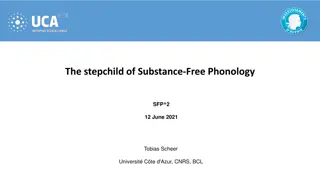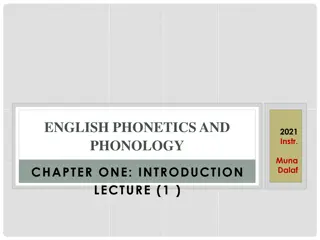Phonetics and Phonology Overview
Phonetics and Phonology are branches of linguistics that study speech sounds and their systems within languages. Phonetics focuses on sound production, transmission, and perception, while Phonology explores how sounds function and relate to each other in a language. Understanding phonemes, allophones, syllables, intonation, stress, and pronunciation variations like rhotic and non-rhotic accents is essential for linguistic analysis and language teaching.
Download Presentation

Please find below an Image/Link to download the presentation.
The content on the website is provided AS IS for your information and personal use only. It may not be sold, licensed, or shared on other websites without obtaining consent from the author.If you encounter any issues during the download, it is possible that the publisher has removed the file from their server.
You are allowed to download the files provided on this website for personal or commercial use, subject to the condition that they are used lawfully. All files are the property of their respective owners.
The content on the website is provided AS IS for your information and personal use only. It may not be sold, licensed, or shared on other websites without obtaining consent from the author.
E N D
Presentation Transcript
1 Facility and Non-Facility NA Indicators CMS NCCI and the Medicare Physician Fee Schedule Please note that the content provided herein is informational only, and should NOT be considered legal, professional, business, practice, insurance, or other advice. Consult CPT instructions and individual payer rules for variations. This information is subject to change and should be verified from time to time.
2 The CMS National Correct Coding Initiative (NCCI) edits are designed to promote proper coding practices, aiming to minimize errors in coding and claims payments. A lesser-known NCCI edit found in the Medicare Physician Fee Schedule (MPFS) RVU files involves the Non-Facility and Facility NA Indicator fields. These fields help identify the appropriate setting for certain services or procedures. When an NA appears in either the Non-Facility NA Indicator (column H) or Facility NA Indicator (column J), it signals that the service is rarely or never performed in that particular setting (see slide 3). Procedures performed in a setting with an NA indicator will often result in denials. Non-facility NA indicator (column H) An NA in this column signifies that a procedure is rarely or never performed in a non-facility setting, such as a physician's office. Many major surgical procedures with a 90-day global period are almost always performed in the hospital inpatient setting. Facility NA indicator (column J) An NA in this column signifies that a procedure is rarely or never performed in a facility setting, such as an ASC or hospital.
4 The MPFS RVU files can be found on the CMS website and are typically updated quarterly in January, April, July, and October. To access the files, download the zip file for the current quarter (in this example, 2024 Qtr 4 - RVU24D).
5 Open the downloaded zip file and select the RVU spreadsheet beginning with PPRRVU in the format desired; in this example, PPRRVU24_OCT.
6 Search the spreadsheet for the relevant CPT code and check the Non-FAC NA Indicator and Facility NA Indicator field to determine whether a service is restricted to a specific setting. In this example, 31276 cannot be performed in a non-facility setting (e.g. physician s office).
7 Also located in the zip file is a PDF providing information on how the Medicare fee schedule is calculated, and descriptors for many of the fields in the PPRRVU spreadsheet. Information on the NA indicator is provided on Page 7. page 7:
8 Chapter 12, Section 20.4.2 of the Medicare Claims Processing Manual provides a comprehensive list of settings classified as facility and non-facility settings. As most payers adhere to CMS guidelines, it's crucial to identify the correct setting before delivering a service. More information about the MPFS can be found in the CMS MLN How to Use the MPFS Look-Up Tool.
9 Payment and Practice Help HCMS has been providing successfully assistance with claims payment, payer policies, regulatory and practice management issues, and other concerns since 2000. For assistance contact the Payment and Practice Help and Medicare Quality Reporting Assistance program at 713-524-4267 or paymentadvocacy@hcms.org.



